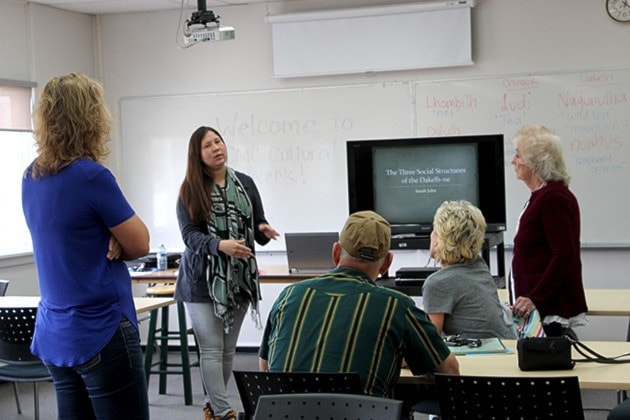A unit of the Aboriginal Cultural Competency workshop presented by Sarah John, Aboriginal Liaison Advisor of the College of New Caledonia
Many misconceptions about Aboriginal peoples in Canada are based on stereotyping and lack of information. These misconceptions have serious consequences and are often at the root of racism and discrimination that Aboriginal peoples continue to experience today.
Dispelling the myths is one step towards building relationships based on mutual respect and trust. Here are some common myths about Aboriginal peoples. Posted around the college is factual information that will help to dispel these myths.
Myth #1: All Aboriginal peoples are the same.
The Aboriginal population is very diverse:
The Aboriginal population is composed of First Nations, Inuit and Metis peoples — each with different history, culture and society. Over 50 Aboriginal languages are spoken in Canada today. Aboriginal peoples live in many different parts of Canada — in geographically diverse locations such as urban centres, rural communities and remote locations.
Myth #2: Aboriginal peoples are responsible for their current situation.
Many factors have contributed to the situation of Aboriginal peoples in Canada. Prior to European contact, Aboriginal societies were strong and self-sufficient.
While Aboriginal peoples were never conquered, the process of colonization resulted in loss of control. Policies of displacement and assimilation i.e. residential schools and banning of potlatch deprived Aboriginal peoples of their traditional, social, economic and political powers.
Aboriginal peoples are now re-establishing control through a process of healing, negotiation and partnership.
Myth #3: Aboriginal peoples have a lot of money.
Aboriginal individuals have lower incomes and higher dependency rates than others in Canada.
By 2006, the income gap had narrowed to $8,135, when the median income of Aboriginal Canadians was $18,962. In 1991, over 40 per cent of First Nations peoples living on reserves received social welfare, as opposed to 17 per cent for the Canadian population at large.
Land claim monies foster community economic growth on a long-term basis, however their impact on individual income is minimal. Given the size of the difference between Aboriginal average income and national average income, it will take a long time to eliminate this disparity.
Myth #4: Aboriginal peoples have everything paid for; they don’t have to pay for their housing, education or medical expenses.
Certain services are paid for. What these are, and they are for, are defined by statute or agreement.
Registered First Nation peoples have certain services paid for. These are part of the federal government’s statutory obligations as outlined in the Indian Act.
When a registered First Nations person leaves the community, access to these rights are limited. And as the federal government cuts spending, items admissible under these statutory obligations also diminish.
Outside of the items defined by statute and agreement, Aboriginal peoples pay their own expenses. For example, you cannot use the equity in your house to take a second loan to start your own business.
If you purchase a house on the reserve, you do not accrue the equity if you have to move out of that house; as well, you may write a will giving it to your children, but the band can choose to give the house to someone else.
Who can call the reserve their home?
Land has been set aside for the use and benefit of the First Nation as a whole; individual First Nation members do not have a right of individual possession except by application of the Indian Act. First Nation councils may enact residency bylaws that regulate on-reserve residency, but these by-laws cannot infringe on individual residency rights arising from the Indian Act.
Myth #5: Aboriginal peoples do not pay taxes.
Tax exemption occurs only in confined cases. Aboriginal peoples pay significant amounts of tax every year.
Inuit and Metis people always pay taxes.
First Nation people without status, and registered First Nations people living off-reserve, pay taxes like the rest of the country.
Registered First Nations peoples working off-reserve pay income tax, regardless of where they reside — even on-reserve. Administrative costs incurred by registered First Nations peoples claiming tax exemptions for off-reserve purchases under $500 discourage requests for reimbursement. In these cases, most registered First Nations peoples opt to pay the sales tax.
Registered First Nation peoples are sometimes exempted from paying taxes. Tax exemption is part of the federal government’s statutory obligation as outlined in the Indian Act.
All the above laws were imposed on First Nations, Metis and Inuit people by the government, without consulting with the Aboriginal peoples.
Myth #6: Aboriginal peoples cannot interface with, or adapt to, life in the mainstream.
Aboriginal peoples have extensive and effective relationships with the rest of Canadian society. Aboriginal peoples attend, and graduate from, a wide range of colleges and universities. Aboriginal peoples work in all parts of the economy — many in large mainstream industries like mining, forestry, banking, construction, etc. Aboriginal businesses form joint ventures — and other business arrangements — with non-Aboriginal businesses.
Myth #7: There are no qualified Aboriginal people to hire.
Aboriginal peoples have the education, skills and expertise required for jobs in all economic sectors. In 1991, over 150,000 Aboriginal peoples had post-secondary education, up from 800 in 1969. This number continues to increase rapidly.
Aboriginal peoples work in many occupations. They are obtaining qualifications and experience in business, finance, administration, management, social sciences; education, natural and applied sciences, and health.
Many services are available to help employers find qualified Aboriginal employees.
